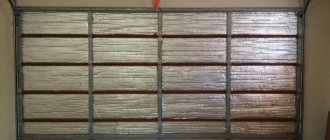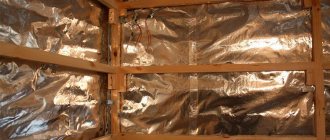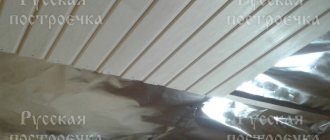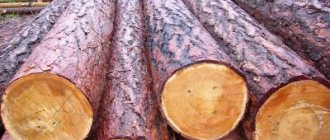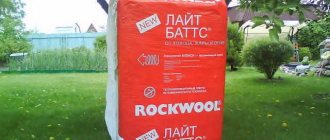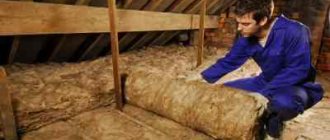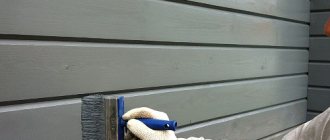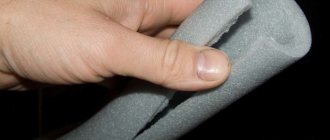Not long ago a new product appeared on the building materials market - foil insulation. It is used for waterproofing, sound insulation and thermal insulation of facades, roofs, walls, floors, ceilings, saunas, baths, partitions, pipelines. What is foil insulation, and how to install it correctly?
Foil insulation is used for waterproofing, sound insulation and thermal insulation of facades, roofs, walls, floors, ceilings, saunas, baths, partitions, pipelines.
What is foil insulation?
Foil insulation is a combined material. On one side it is a polished foil, and on the other, pre-foamed polyethylene. Thanks to its “aluminum” component, it is capable of reflecting and retaining heat in the room. According to research, the reflection effect is 97%. It is distinguished by its thinness and excellent water-repellent qualities, so that the walls and floors do not become damp. In addition, this material perfectly protects the building from wind and frost. Due to the properties of foil, almost all the heat remains inside the room.
Among the advantages of such insulation, experts also highlight excellent soundproofing properties, ease of installation and high environmental friendliness. It does not emit hazardous and toxic substances, unlike conventional mineral wool and other modern analogues. Due to its elasticity, foil insulation is easily and safely mounted on the surface, and even a non-professional can install it correctly simply using the simplest instructions.
Types of foil insulation
Foil insulation does not emit hazardous and toxic substances, unlike conventional mineral wool.
There are four types of such insulation; they differ from each other both in appearance and in their area of application and functional features.
- Foamed polyethylene coated with aluminum is used to insulate building walls and ventilation systems. Usually sold in roll form.
- Foiled polystyrene foam is used for floor insulation. It is produced in the form of thick steel-colored sheets.
- Mineral wool with a layer of foil is used mainly for insulating roofs, chimneys and baths. Sold in rolls.
- Basalt foil-coated thermal insulation material is used in all areas of construction, including the construction of gas stations. It has increased resistance to aggressive environments. Withstands temperatures from -200°C to +700°C.
Lavsan - description and basic properties of the material
Polyethylene terephthalate (PET or lavsan) is a thermoplastic from the polyester class. The material is durable, resistant to wear and moisture. Polyester film is used in various industries - from the manufacture of packaging for food and medicine, to the lamination of fabric used for thermal insulation. Wide possibilities of use are due to the properties of polyester: frost resistance, low vapor and gas permeability, wear and tear resistance.
Metallized film is offered for thermal insulation of floors, roofs, walls, pipelines and ventilation systems. It is a composite of aluminum and lavsan. The reflective material is welded with gas-foamed polyethylene, which increases the resistance to heat and sound transmission.
The thickness of the metal layer determines the reflectivity of the insulation; if it is extremely thin, then infrared radiation is weakly reflected. The size and quality of aluminum insulation coating cannot be determined visually, so to protect yourself from counterfeiting, you should buy products from well-known brands: Izolon, Izodom, Penoplus, Thermodom.
Lavsan insulation, soldered to a polyethylene foam base, has several important advantages:
- low thermal conductivity;
- sound insulation effect due to the presence of air layers;
- protection from moisture and steam due to the surface density and resistance of the film to moisture;
- low weight and thickness of the insulation layer do not create a load on the structure and do not take up free space;
- fire safety, the canvas does not burn and does not emit toxic smoke;
- resistance to chemical reagents (acids and alkalis);
- dielectric properties.
Installation: how to do it right?
Foil insulation is ideal for insulating floors, bathhouses and attics.
Required tools and materials:
- construction stapler;
- small nails;
- hammer;
- foil insulation;
- foil tape.
Many people, having bought foil insulation, wonder which side to lay it on correctly?
So, the first thing to consider is that the reflective surface of the insulation must be located indoors.
This is necessary to keep the heat in the room. In addition, it is important to leave a distance between the finish and the material of about 15-20 mm; this kind of air cushion will provide additional heat protection.
When laying on an insulated surface, the material must be in a wooden sheathing (2-3 cm thick) between the guides. Correctly attach it to the wall not overlapping, but end-to-end, using nails or a stapler. After all the sheets have been laid, the joints between them are taped with special foil tape. At this point the installation can be considered complete.
The cost of any insulation with aluminum foil is comparable to the cost of an alternative material with similar characteristics, but due to the fact that its installation is very simple, you can save a lot of time on installation and space (foil insulation is thinner than conventional ones). In addition, this material is environmentally friendly and fireproof. Before you choose and buy foil insulation, make sure that it is covered with aluminum foil and not aluminum coating. In the second case, the reflective properties of the material are unlikely to work correctly.
Features of foil insulation, some disadvantages and scope of application. How to properly install penofol with glue. The choice between penofol and basalt wool.
general information
In short, this material is an improved version of standard insulation. Its use reduces not only heat loss in rooms, but also heat exchange between the street and the room. In its structure it has two layers:
- The base is foamed polyethylene or mineral wool. Often the base is expanded polystyrene, produced using foam technology.
- The second layer is aluminum foil. The thickness of this layer varies in the range from 7 to 15 microns.
When producing reflective insulation, the foil is simply soldered to the base. Most companies that produce this insulation option supply it in rolls. It is extremely rare to find it in the form of slabs.
Specialized stores offer single-sided and double-sided reflective insulation. In the latter case, the foil material is located on both sides. When carrying out work indoors, in order to reduce heat loss, owners most often use rolls of one-sided insulation.
Insulation with two-layer models is most effective for insulating heating mains and pipelines. This option is also used at industrial facilities.
Nowadays, reflective materials are produced by a large number of enterprises. In Russia, brands such as Penofol and Teplofol have proven themselves well. A special feature of the products of these companies is the presence of an adhesive layer. Thanks to it, laying the material is easier. Most manufacturers produce reflective insulation based on polyethylene foam.
How to install reflective insulation:
Large market participants - Rockwool, URSA and ISOVER - also produce foiled mineral wool. It varies not only in thickness, but also in density. In the product line of these companies you can find insulating mats and cylinders. They are used for work on insulating communications facilities and protecting pipelines from heat loss.
Advantages and disadvantages of the method
Insulation with foil has a number of features and a minimum of negative aspects. Advantages:
- Foil reflects heat. Thus, the heat remains in the house, on the other hand, it does not allow heat to enter the house in the summer.
- Increased wear resistance.
- Partially applicable as a waterproofing material.
- Easy installation, light weight, simple dismantling.
- The insulation does not allow cold wind to pass through. Maximum insulates from external influences. Resistant to deformation due to sudden temperature changes.
- Keeps out noise from the street.
- Does not rot or mold.
- This material is thinner than others, but is 20-30% more effective.
- The insulation does not emit substances harmful to health and prevents the smallest irritants and allergens from getting inside.
- There is no rigidity, so the top cannot be covered with plaster or wallpaper.
- Special adhesives are required for fixation.
- Sometimes insulation with foil is not enough to insulate a room.
Despite the disadvantages, foil material is widely used for various purposes.
Where is the foil insulation method used?
Foil insulation reflects infrared rays, which are essentially thermal rays. But there is no need to use the material everywhere. In some places it will not work properly.
It is mainly installed near thermal energy sources:
- heating devices - batteries, air heaters. The insulation is mounted on the wall with foil in the room;
- boiler, fireplace stove.
It is also used when installing “warm floors”. The reflective layer will direct the heat in the desired direction.
Small spaces where every centimeter plays a role. Here, thin insulation would be appropriate on the walls and ceiling.
In the attic. Here the insulation is installed on the roof. Apply 2 layers to combat heat and cold.
In baths and saunas. The heating of the room is not constant; foil material is suitable for such purposes.
Garages, hangars, outbuildings - an installed radiator or potbelly stove.
They also insulate heating pipes, air ducts, wells and wells.
What insulation and why is it better to choose?
The appearance of foil on insulation led to the differentiation of its areas of application. Materials now have a narrow specialization.
Foil polyethylene foam
Foil-rolled polyethylene foam insulation in the class of reflective insulation has the widest range of applications. It is used for insulation:
- • floor. It is used as an additional thermal insulation layer in individual construction and the main one in apartments of multi-storey buildings. At the same time, it can simultaneously perform the functions of waterproofing materials. Insulation with a thickness of 2-3 mm is used as a substrate for parquet, laminate or linoleum floors;
- walls and ceilings. The material is especially in demand in conditions of limited space (balcony, loggia), since the small thickness of thermal insulation minimally “steals” the usable area;
For reference: More details about the problem of thick insulation for walls indoors can be found on the StroyGuru website in the work “Insulation for walls from inside a house or apartment.”
- roofs. Used alone or in combination with other types of insulation;
- baths At the same time, it performs two functions: heat and vapor barrier, protecting walls and ceilings from heat loss and waterlogging. But there are exceptions: they cannot be used in steam rooms and saunas, as they become deformed due to high temperatures.
Another area of application available only to this type of insulation is heat-reflecting screens behind heating devices: radiators, air heaters, infrared films located on the walls and ceiling. This measure allows you to save thermal resources, and in significant quantities.
Foiled polystyrene foam
The main task of foil foam is to direct the downward heat flows of all types of “warm floors” back into the room. It is not used for other purposes, although the instructions do not prohibit it. The reason is the prices. With almost the same effect, you can insulate the walls with polystyrene foam without foil, which will cost about two to three times less.
The use of foil polyethylene foam is not limited to construction. It can be found in agriculture (insulation of calf barns, incubators), automotive (insulation and sound insulation of passenger car interiors) and footwear (warm insoles) industries.
Foil glass wool (mineral wool)
Like foam plastic, foiled glass wool has a narrow specialization - it is the main type of insulation for baths (primarily steam rooms) and saunas, although nothing prevents you from insulating a roof or attic with wool and foil.
The high heat resistance (+300oC) of glass wool with a foil side has made it possible to increase the scope of its application. It is widely used for thermal insulation of boilers, boilers, and pipelines. At the same time, collapsible cylinders or half-cylinders of different sizes, both in length and diameter, are produced specifically for pipes.
Foil basalt wool
The excellent thermal insulation properties of basalt wool do not require a layer of foil when insulating residential premises. This type of insulation can only be afforded by consumers with unlimited financial capabilities. Therefore, foiled stone wool is used mainly for insulating buildings with a high level of fire danger (withstands up to +700oC), for example, gas stations. In this case, the external walls (facade) are insulated.
Foil insulation design
Thermal insulation with foil is produced in:
They differ in size, thickness and the foil-covered base layer used.
Base layer types:
- polyethylene foam;
- basalt wool;
- expanded polystyrene.
The foil is glued to the base layer or applied by spraying.
Some have layers of foil on both sides. Or with a layer of applied glue - self-adhesive, which allows for easy installation. Self-adhesive is used in corners and on uneven surfaces. The joints of the insulation are taped with foil tape.
When purchasing insulation with a reflector, you need to pay attention to:
- base layer;
- foil thickness;
- taped with a reflector on one side or both.
The thickness of the insulation itself depends on the base material used.
How to use VPE insulation
Reflective insulation lavsan VPE can be mounted on surfaces with any configuration. The material is effective in low-rise construction, and the panels are attached end-to-end, and overlap must be avoided. The joints must be sealed with special foil tape with an adhesive layer. You can use a composite of polyethylene and aluminum for this.
The connecting element is characterized by strength, as well as moisture resistance and the ability to reflect infrared radiation and ultraviolet radiation. The service life can reach the time of use of the foil layer itself. By using Dacron WPE reflective insulation, you can reduce your heating costs and achieve significant energy savings.
Types of foil penofol
There are 3 types of penofol with foil on sale. Each is marked with Latin letters, which indicate the packaging.
Folgoizolon for external and internal work
TYPE A – heat insulator made of polymer, foil layer on one side. Produced in different thicknesses. Suitable for complex insulation of buildings inside. Glass wool is used together with this insulation. They also produce foil insulation with perforation. It is installed in log houses to allow the wood to “breathe.”
TYPE B – foil is located on both sides. This is maximum protection against heat loss. Penofol type “B” is used for thermal insulation of the attic, supporting structure, basement, and floor. As well as insulation of the pipeline and heating system.
TYPE C - on one side there is foil, on the other there is a thin layer of glue protected by film. Self-adhesive penofol is easy to install without spending a lot of time. For installation, cut into pieces of the required length and glue to the prepared surface.
TYPE R – a complete comparison to type “A”, but with a pattern on the foil. Used as decor for indoor walls. And also with multi-layer insulation, creating an air gap.
TYPE ALP – high degree of reflection. This insulation is used in agriculture, for example, to insulate incubators or buildings for calves.
Type NET is analogous to type “B”. Produced in narrow rolls or coils. Used for pipeline insulation.
2000 Type C – reduced performance. The adhesive layer is of poor quality and has poor adhesion.
What is better - foil penofol or basalt insulation?
The building materials market is full of types of insulation. They have their own characteristics, positive and negative sides.
General thermal insulation parameters:
- Weight. The insulation should not weigh much, because when installing it on the structure there should be no weight.
- Thickness. The thinner the material, the more space remains in the room.
- Low thermal conductivity.
- Moisture permeability. The material should absorb moisture as little as possible.
- Noise insulation. Does not allow sounds from the street to pass through.
- Environmentally friendly material. Should not emit harmful substances.
- Easy to install.
When comparing basalt insulation and foil penofol, you need to compare their characteristics.
Basalt wool
Made from rock of volcanic origin. It does not burn, has good sound insulation properties, and does not lose its qualities over time. It is completely safe for health.
Penofol - application
Made from polyethylene foam with a porous structure. A layer of foil is glued on top as a heat reflector. This thermal insulation material is several times thinner than basalt wool. In addition, it reflects heat and practically does not absorb it.
Pros of reflective insulation
- Reasonable price with fairly high quality material;
- Easy to use. Installation does not require special skills or expensive tools;
- Compactness and elasticity of the material. Due to its compactness, it can be used in many different areas. And due to its elasticity, installation work in hard-to-reach places is simplified;
- Good hydro- and vapor barrier properties;
- Good noise absorption. We all like silence in the house; almost all types of reflective thermal insulation perfectly block out the majority of sounds from outside;
- Environmental friendliness. Does not cause harm to health, as it is made from safe materials;
- Fire resistance. All reflective insulators are made from fire-resistant materials;
- Durability. These materials do not rot, due to which they retain almost all of their heat-insulating properties for a very long time.
The most popular type of insulation with foil for interior finishing is aluform
Bestizol or alufom is a bubble base consisting of aluminum foil (outer layer) and polyethylene (inner layer) on one side. The foil acts as a reflector of solar and heat rays. The polyethylene layer has a cellular structure and neutralizes sound waves and shocks. The advantage of this material is low thermal conductivity.
Bestizol can be used in both cold and hot weather. Due to its small thickness (1 cm), the material is used for hard-to-reach places:
- for winding ventilation pipes;
- air duct coverings;
- insulation of pipelines and other outlet communications.
Installation of rolled foam foam inside and outside: how to stick it?
Basic installation rules:
- The material is mounted straightened, uncompressed, without folds. Fix to the lathing or directly to a clean surface.
- Penofol is secured with foil towards the heat to reflect it. This is an obstacle to the release of thermal energy to the street.
- The material is glued end to end. The borders are taped to seal.
- To glue the insulation, special types of glue or a self-adhesive type are used.
Installation is quick and easy, both inside and outside. The work is identical in sequence and principle inside and outside. It is easy to cut and quickly installed.
Before gluing penofol, you do not need to pay attention to its weight. The material is lightweight and can be supported by universal glue. But, for strength, they purchase adhesive compositions intended for this purpose.
The adhesive must correspond to the characteristics of the thermal insulation material:
- temperature range +100/-600C;
- indoor use, not outdoor use;
- non-toxic;
- good adhesion.
The adhesive composition should not emit harmful substances. Penofol is able to absorb 3% of heat, which means the glue on the back side can also warm up.
How to glue insulation with foil to the wall near the radiator and door
For gluing the surface and penofol, craftsmen recommend purchasing the following brands:
- Weicon Easy-Mix PE-PP 45. Two-component adhesive designed for gluing concrete (brick) surfaces with polyethylene, polypropylene.
- Moment - has many positive aspects, including good adhesion. The glue will quickly and permanently bond the insulation to the surface behind the radiator or near the door.
- Liquid nails are capable of fixing heat-insulating material for a long time.
Other brands: Titan, Tilit, Atlas Stopter K-20 kley, Ceresit (ST83).
Life time
Since foil insulation appeared relatively recently, it is not yet possible to determine the exact expiration date. However, after conducting experiments, we can say that the material does not lose its properties for 200 years.
The service life of the installed insulation depends on the adhesive used. If the adhesive composition has passed its expiration date, then you can re-install it with the same heat insulator.
There are a lot of insulation materials on the construction market. The choice is so wide that the question arises, which is better. To answer, you need to compare the characteristics of the thermal insulation material and the scope of application - street, living room, garage or agricultural building.
Advantages of insulating material with foil
Foil insulation has many advantages that other materials often lack. It is these “advantages” that make insulation with foil stand out against the background of a wide variety of insulation products:
- Increased ability to reflect heat. Foil is a wonderful reflector that can repel about 95% of thermal radiation, keeping the house warm and keeping the heat out. By the way, it is for this reason that protective suits for firefighters are made from foil insulation.
- Waterproofing. Foil is a hydrophobic material that repels moisture.
- Ease of use. Foil insulation has a cellular structure, due to which it not only insulates well, but is also easy to install.
- Isolation from external influences. Foil insulation does not allow wind and moisture to pass through, does not freeze in winter and does not dry out in the hot season.
- Noise absorption - the use of insulation with foil allows you to achieve silence in the room and significantly reduce the amount of noise coming from outside.
- Health safety and environmental friendliness. Foil has no harmful effects on the human body, does not emit potentially hazardous substances and does not harm the environment.
- Durability. Reflecting all external influences, the foil can serve for a long time without any signs of rust, rotting or corrosion.
- Elasticity. The foil material can be easily given any desired shape.
The use of lavsan film during the installation of “warm” floors
The heat insulator lavsan is especially popular
received as a substrate during the installation of a “warm” floor system. For good heating performance, equal heat distribution is necessary. Reflective insulation prevents energy loss through the base, and the infrared waves emitted by TEN are reflected into the room. The waterproof properties of the heat insulator protect the system from moisture from the ground or basement. It has good resistance to deformation, varies in elasticity, and can withstand heavy loads.
The correct use of lavsan film is determined by its resistance to aggressive environments. With prolonged contact, a concrete screed causes corrosion of the metal, so replacing aluminum-based foil with lavsan increases the service life of the substrate.
The reflective substrate works for the same distribution of warm air with any type of heated floor, but when laying electrical cables and film floors
she is irreplaceable.
The lavsan heat insulator is considered a dielectric and ensures complete operational safety of the system, preventing the possibility of short circuits.
When laying thermal insulation, the panel must be divided over the entire area of the base, not excluding places where the installation of a film floor . The joints of the insulating strips are coated with glue using specialized foil tape. The reflective layer is directed towards the room.
This type of underlay is very often used when tiles are considered the final floor covering. This material has a cold surface and requires intensive heating.
Technical characteristics and cost of materials with foil
The technical characteristics of all existing foil insulation cannot be named at once - different materials have different properties. However, it is possible to give the characteristics of several of the most popular insulation materials.
Universal insulator made of polyethylene foam
The material is usually supplied in roll form. Its thickness can vary from 2 mm to 1 cm. Polyethylene foam can be covered with foil on one side or both. In addition, self-adhesive versions of such insulation are produced, when an adhesive layer is applied to the material on one side, covered with a protective film. The thermal conductivity of polyethylene is 0.038 W/(mK), the specific gravity of a material with a thickness of 0.5 cm is 60 kg/meter. Moisture absorption by different types of this material can range from 0.6% to 3%. The use of polyethylene insulation with foil is usually not limited to any framework: the material can be used to insulate walls and floors in a room, a ventilation system, the roof of a building, insulate pipes or refrigerators. Foamed polyethylene with foil is often used to install heated floors under screed, as a finishing base for laminate or linoleum, and for thermal insulation of saunas.
Purpose of VPE lavsan insulation
Reflective VPE insulation is made from polyethylene foam and has a silver surface. This material is practical, ready to last for a long time, affordable and versatile. It is used for noise and heat insulation of premises for various purposes. With its help, you can achieve partial vibration damping. The products are placed under the decorative coating of the floor, ceiling and walls, and they can be used even in conditions where high humidity will remain during operation.
The use of foil thermal insulation materials
The use of insulation with foil always depends on two indicators: the properties of the place in which they will be used, and the properties of a particular insulation. In general, foil materials insulate the floor, increase heat transfer from radiators, and insulate pipelines and air ducts for various purposes. Insulation of entrance doors, entryways, balconies and verandas also has a significant effect.
